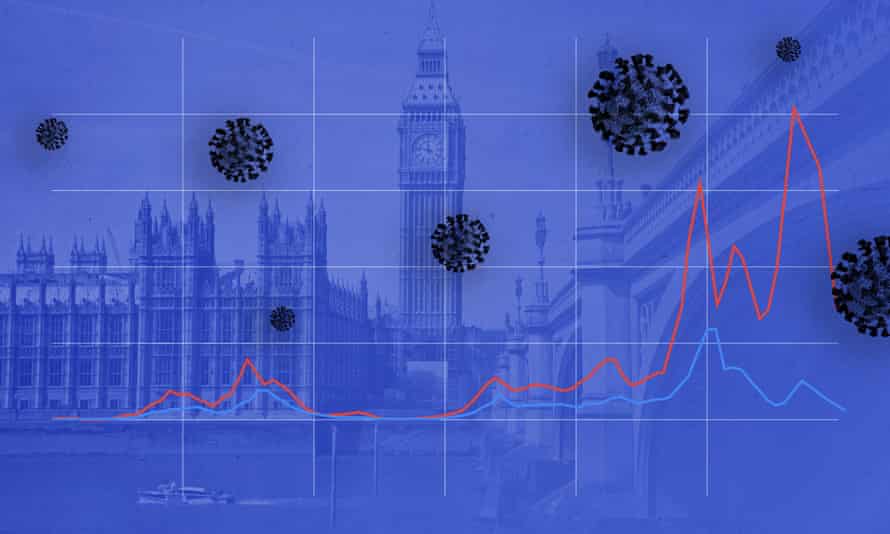

For almost two years we’ve been glued to a set of numbers: the grim trio of cases, hospitalisations and deaths that defined coronavirus in the UK.
The daily figures led news reports for more than a year: people watched in horror as the height of the Omicron wave brought the highest ever daily caseload on Tuesday 4 January 2022 when 275,618 people tested positive. And they saw how many people died: a number that peaked on Tuesday 19 January 2021, when 1,366 people died, making it the the worst day of the pandemic*.
Since March 2022 case numbers from the daily government dashboard have tumbled. A fall that has coincided with the government’s Living with Covid plan: as restrictions fell away in England, so did cases. The government ended restrictions including the legal requirement to self-isolate on 24 February and cut the provision of free tests on 1 April.
150,000Seven-day rolling average of new cases50,000100,0000Oct2020OctJan2021JulAprJan2022AprAlpha waveDeltaOmicronOmicron wave1 AprilFree testsend
After two long years of disease, restrictions and fear – it’s the news everyone has been hoping for.
But have cases really gone down that fast?
Like all statistics – the UK’s coronavirus statistics are a way of measuring something – but not the thing itself.
It’s not hard to see that as the government cut free NHS tests and people weren’t able to report private tests, the total number of tests fell, and so did the number of positive tests. Then, by the government’s measurements at least, cases fell.
And falling cases made it look like the government was justified to cut tests.
The good news? Cases are on a downward trend. But it hasn’t been as fast or as rosy as the government charts have made out.
<!–
But the story looks different when you compare government numbers to those from the ONS
–>600,000200,000400,0000Oct2020OctJan2021JulAprJan2022AprGovernment figuresONS figuresEarly in the pandemic, ONS numbers are higher but follow the same trendDuring Omicron the ONS numbers become much higherThe ONS spike in March is almost completely missed by gov.uk figures
Looking at the weekly coronavirus infection survey from the Office of National Statistics (ONS) – puts the recent fall in perspective.
What the government (coronavirus.gov.uk) case numbers actually measure is not the number of of new people in the UK infected with coronavirus every day. But, the number of people who take a test, get a positive test result, and then report that test.
Why ONS cases are so much higher
Throughout most of the pandemic, government numbers were recording about a third of the cases that the ONS was picking up.
Instead of relying on people choosing to take a test, the ONS numbers are estimates based on a sample of around 200,000 people across the UK who take a test every month regardless of whether they have symptoms. This makes the ONS system better at catching asymptomatic infections, and better at picking up milder variants like Omicron.
However the ending of free tests sees that relationship break down with the gov.uk figures almost entirely missing the March 2022 spike and recording less than a twelfth of the cases that the ONS picked up at the start of April
But the overall picture is positive. On all measures – cases are down. Vaccination levels are high, antibody levels are high, and the spread of infectious disease tends to reduce in the summer. But that won’t last for ever.
How will we spot the next wave?
In all four scenarios considered by the Scientific Advisory Group for Emergencies of how the pandemic will unfold, there is a resurgence in the autumn/winter of 2022. In the best case, it is a small one.
Given that this will happen, it is vital to maintain virus surveillance system and the ability to ramp up protection measures again, as Sir Patrick Vallance, the UK government’s chief scientific adviser, argued at the launch of the Living With Covid plan.
But the warning system doesn’t have to come from the daily numbers we have got used to on the government dashboard. Prof Kevin McConway argues that daily cases numbers from the gov.uk dashboard were always more about news cycles than actual health surveillance.
“The data from tests did help, but the numbers and rates were always subject to biases of unknown size, because they depended on who was turning up to be tested,” he says. “That varied – some people had jobs that required frequent testing, and those requirements changed over time; some people might not choose to be tested even if they knew, or suspected, they had symptoms because they would lose their income; at a few times tests were difficult to get.”
Even before people had to turn to private tests on 1 April, we see a big dip in testing – showing a change in attitude to the virus, as much as people reacting to the price change.
UK testing peaked in January 2022
<!–
–>
Registered coronavirus test results and number that are positive, by date of publication.
5 April 2020 had the highest percentage of positive test results.
4 January 2022 had the highest number of registered tests.
*From 26th Feb 2022: no case data is published on Saturdays or Sundays and figures published on Monday include three days’ data, so case data is removed
from this label on these days to allow for accurate comparisions over time.
Test data continues to be reported as normal over the weekend.
Data: data.gov.uk.
updated
“Even if free tests were still available now, people’s propensity to ask for them would have changed a lot because of the perception that the disease isn’t as important or dangerous as it was,” says McConway. “That partly stems from government policies and announcements but by no means all of it – it would have happened anyway.”
Data from GPs and Google searches
The UK Health Surveillance Agency (UKSHA), which has taken over from Public Health England, is continuing to publish Flu and Covid-19 Surveillance reports that draw together data sources including the ONS infection survey but also information from GPs and hospitals, places outside the health system such as care homes and schools, and even sources such as Google searches for symptoms and reports of disease outbreaks at workplaces like restaurants.
More creative data sources such as sewage have even been used to gauge coronavirus levels in the population. Though are not currently referenced in the surveillance report.
The emergence of a more transmissible or more deadly variant is one of the key areas of concern for next winter so continued genomic sequencing of samples is required to keep track of how the virus is mutating. And blood samples will continue to be needed as antibody levels give an indication of immunity.
McConway says the UK has decent measures in place to keep track of diseases that get less media attention than coronavirus.
“What’s unique about Sars-CoV-2 is the scale of the pandemic, and the public and government and media interest, and some of that led to different and more elaborate and expensive surveillance approaches, but lots of things go on all the time without most people noticing.”
So as with flu – it is likely authorities will see the warning signs before a new surge hits in the winter. The question is then – as Vallance notes – whether the government will act on it.
The Guardian’s UK coronavirus tracker will switch over shortly to use ONS infection survey numbers for cases, instead of the gov.uk numbers
Notes:
* Gov.uk counted 275,618 new cases by specimen date on 4 January 2022 in the UK – the highest daily caseload for the pandemic. The date with the highest number of cases by date reported was also the 4 January 2022 with 218,724 new cases (for the period when the government was publishing figures daily).
Gov.uk counted 1,366 deaths within 28 days of a positive test by date of death on 19 January 2021, in the UK. The worst day for deaths by date reported within 28 days of a positive test in the UK is 20 Jan 2021, when 1,820 deaths were reported.


